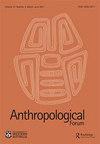破碎的城市:全球住房危机的内幕
IF 0.7
3区 社会学
Q3 ANTHROPOLOGY
引用次数: 0
摘要
专门关于朋克和嘻哈的课程。对于一本标题中既包含朋克又包含嘻哈的书来说,这是一部奇怪的无声作品,只通过他所说的“反叛美学”的视觉表现来参与这些“亚文化”——“集体实践和情感”体现在“改变公共空间的干预,如直接行动,以及带有反对信息的壁画和模板涂鸦”(14-15)。虽然Magaña声称2006一代“迫使我们超越艺术家/活动家的二分法,以便充分理解艺术家的作品往往是社会运动的核心”(17),但这一主张并没有得到充分阐述。他对个别艺术家及其作品的强调也提出了一个问题,即横向组织如何通过基于或构建更广泛的集体意识的创造性实践来实施。虽然艺术家在社会运动组织中的角色尚不清楚,Magaña实现了他的主要目标,提供了一个深入观察2006年后瓦哈卡边缘化青年的特定交叉点,如何通过日常水平实践来实现更公平社会的愿景。这本书对世界上一个研究太少的角落提供了丰富的民族志数据,为其他人加入并扩展Magaña和他在瓦哈卡的合作者建立的有价值的对话打开了大门。本文章由计算机程序翻译,如有差异,请以英文原文为准。
Broken Cities: Inside the Global Housing Crisis
course specifically about punk and hip-hop. For a book that contains both punk and hip-hop in its title, it is a strangely soundless work, engaging with those ‘subcultures’ only through visual manifestations of what he terms a ‘rebel aesthetics’ – the ‘collective practices and sensibilities’ embodied in ‘interventions that transform public space, like direct actions, as well as murals and stencil graffiti with oppositional messages’ (14–15). Though Magaña claims that the 2006 Generation ‘compels us to move beyond an artist/activist dichotomy in order to fully appreciate the ways that artists’ work is often central to social movements’ (17), this assertion is not fully elaborated. His emphasis on individual artists and their works also raises the question of how horizontal organisation may be enacted through creative practices that are either grounded in or construct a broader sense of collectivity. Though the role of the artist in social movement organising remains unclear, Magaña fulfills his primary objective in providing an in-depth look at how a particular intersection of marginalised youth in Oaxaca, post-2006, experimented with everyday horizontal practices to realise a vision of a more equitable society. The book’s wealth of ethnographic data on a too-little studied corner of the world opens the door for others to join and extend the valuable dialogues that Magaña and his collaborators in Oaxaca established.
求助全文
通过发布文献求助,成功后即可免费获取论文全文。
去求助
来源期刊

Anthropological Forum
ANTHROPOLOGY-
CiteScore
3.60
自引率
10.00%
发文量
14
期刊介绍:
Anthropological Forum is a journal of social anthropology and comparative sociology that was founded in 1963 and has a distinguished publication history. The journal provides a forum for both established and innovative approaches to anthropological research. A special section devoted to contributions on applied anthropology appears periodically. The editors are especially keen to publish new approaches based on ethnographic and theoretical work in the journal"s established areas of strength: Australian culture and society, Aboriginal Australia, Southeast Asia and the Pacific.
 求助内容:
求助内容: 应助结果提醒方式:
应助结果提醒方式:


